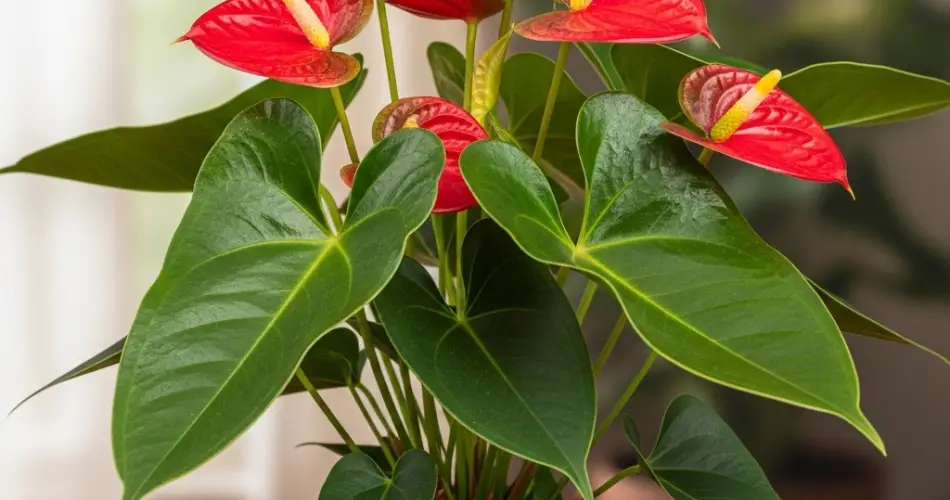Anthuriums are striking tropical houseplants, famous for their glossy, heart-shaped leaves and long-lasting flowers. While relatively easy to grow indoors, these plants have specific moisture requirements that can be confusing for plant owners. One common question is whether misting or watering is more effective for keeping anthuriums healthy. Understanding the difference between the two—and when each is appropriate—is crucial to maintaining vibrant foliage and promoting long-lasting blooms.
Understanding Anthurium Moisture Needs
Anthuriums are native to tropical rainforests, where they grow in humid environments with filtered sunlight. Their roots and leaves have adapted to capture water efficiently, but they are not tolerant of excessive moisture sitting on their roots. Proper hydration involves providing enough water to the root zone while maintaining the right level of humidity around the plant.
-
Roots: Anthurium roots are sensitive to waterlogging. Overwatering or poor drainage can quickly lead to root rot, yellowing leaves, and stunted growth.
-
Leaves: While leaves benefit from humidity, they do not absorb significant amounts of water through misting. The primary source of hydration is the soil.
Balancing these factors is key to a healthy, thriving anthurium.
Misting: What It Does
Misting involves lightly spraying water onto the leaves or surrounding air to increase humidity. For some tropical plants, misting can help prevent dry leaf tips and mimic rainforest conditions.
Benefits of misting for anthuriums:
-
Increases humidity around the plant, which can prevent browning leaf edges.
-
Helps dust settle off leaves, keeping them shiny and healthy.
Limitations:
-
Misting does not hydrate the plant’s roots. The leaves cannot absorb enough moisture to replace soil watering.
-
Excess misting without proper air circulation can create a breeding ground for fungal infections or leaf spots.
Misting is best used as a supplementary practice, particularly in dry indoor environments, but it should never replace proper watering.
Watering: The Primary Source of Hydration
Watering is how anthuriums receive the moisture they need for growth and flower production. Proper watering nourishes the roots, supports nutrient uptake, and maintains overall plant health.
How to water effectively:
-
Check soil moisture – Stick your finger about an inch into the soil. Water only when the top layer feels dry.
-
Water thoroughly – Pour water evenly over the soil until it drains from the bottom of the pot. This ensures the entire root system receives hydration.
-
Drain excess water – Never allow the pot to sit in standing water. Drainage holes are essential to prevent root rot.
-
Use room-temperature water – Cold water can shock the roots, while water that is too warm may stress the plant.
A consistent watering routine, adjusted for season and environment, is the most reliable way to keep anthuriums healthy.
Combining Misting and Watering
While watering is the main method for hydrating anthuriums, misting can complement it in certain situations:
-
Dry indoor air – During winter or in air-conditioned rooms, indoor humidity may be low. Occasional misting around the plant (not directly on leaves for long periods) can help maintain ideal humidity levels.
-
Supplementing hydration without overwatering – If the soil is still moist, misting can provide a temporary increase in humidity without risking waterlogged roots.
However, misting should be limited and combined with good airflow to prevent fungal issues. The soil should always remain the primary source of water.
Common Mistakes to Avoid
-
Replacing watering with misting – Anthuriums require root hydration; misting alone cannot sustain them.
-
Overwatering while misting – Extra humidity does not reduce the need to check soil moisture before watering.
-
Misting in stagnant air – Without ventilation, leaves stay wet for too long, encouraging disease.
-
Using poor-quality water – Tap water high in chlorine or fluoride can damage leaves. Use filtered or distilled water when possible.
Avoiding these mistakes ensures both the roots and foliage remain healthy.
Seasonal Adjustments
Anthurium watering needs vary with the seasons:
-
Spring and Summer (active growth) – Water more frequently, keeping the soil evenly moist but not soggy.
-
Fall and Winter (slower growth) – Reduce watering and allow the top layer of soil to dry between sessions.
-
Humidity adjustments – During dry months, occasional misting can maintain adequate humidity, while in naturally humid environments, it may not be necessary at all.
Final Thoughts
Misting and watering serve different purposes for anthuriums. While misting can improve humidity and prevent leaf tip browning, it cannot replace proper watering. The roots must receive consistent hydration through soil moisture, while misting acts as a supplement in dry conditions.
By combining proper watering practices with occasional misting when necessary, you can maintain a healthy, vibrant anthurium with lush foliage and beautiful flowers. Paying attention to soil dryness, seasonality, and environmental humidity ensures your plant thrives year-round, making it a striking addition to your indoor garden.



